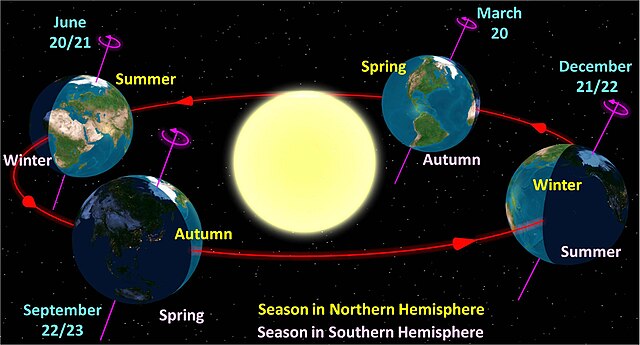The summer solstice or estival solstice occurs when one of Earth's poles has its maximum tilt toward the Sun. It happens twice yearly, once in each hemisphere. For that hemisphere, the summer solstice is the day with the longest period of daylight and shortest night of the year, when the Sun is at its highest position in the sky. At either pole there is continuous daylight at the time of its summer solstice. The opposite event is the winter solstice.
Earth during the summer solstice in June 2017
Diagram of Earth's seasons as seen from the north. Far left: summer solstice for the Northern Hemisphere. Front right: summer solstice for the Southern Hemisphere.
The solstice being celebrated at Stonehenge in England
The winter solstice, also called the hibernal solstice, occurs when either of Earth's poles reaches its maximum tilt away from the Sun. This happens twice yearly, once in each hemisphere. For that hemisphere, the winter solstice is the day with the shortest period of daylight and longest night of the year, and when the Sun is at its lowest daily maximum elevation in the sky. Each polar region experiences continuous darkness or twilight around its winter solstice. The opposite event is the summer solstice.
Sunset at Stonehenge in England during the winter solstice in the Northern Hemisphere
The seasons with the transition points of the June solstice, September equinox, December solstice, and March equinox
Sunlight entering the passage of Newgrange in Ireland on the winter solstice
Neolithic site of Goseck circle in Germany. The yellow lines indicate the directions in which sunrise and sunset are seen on the day of the winter solstice.






